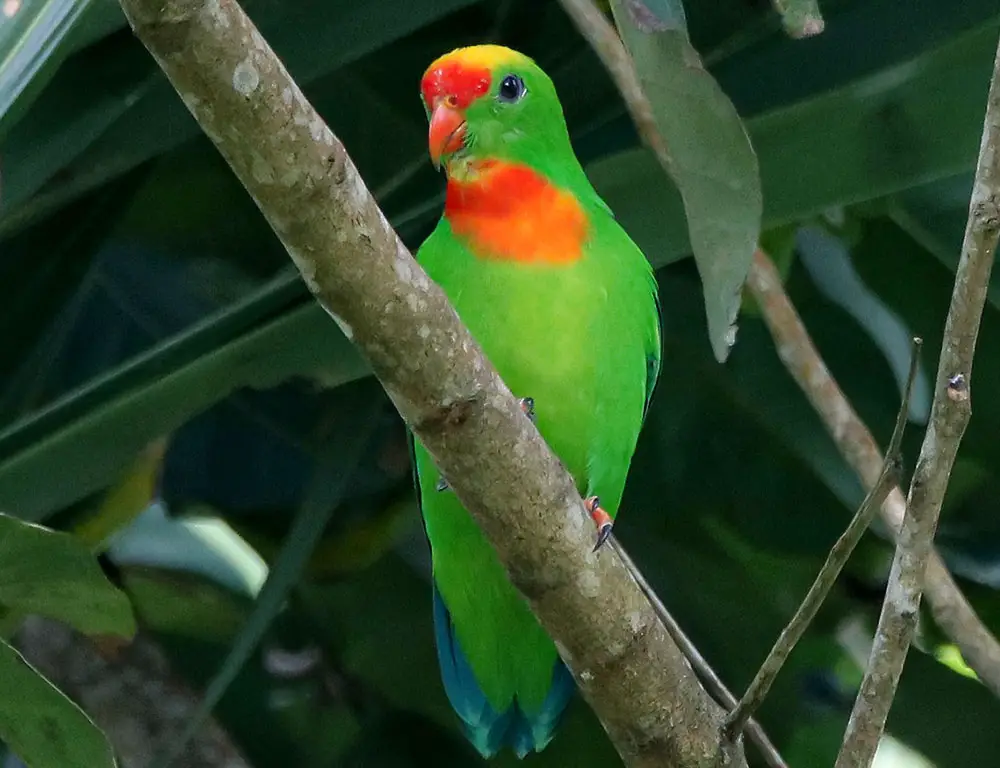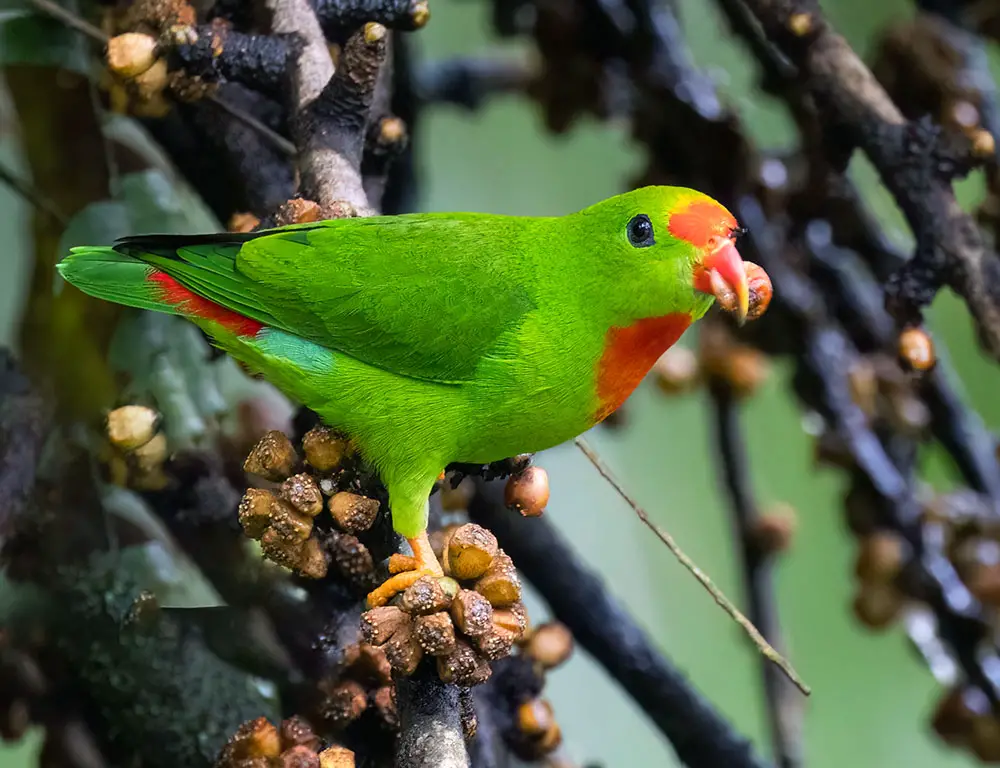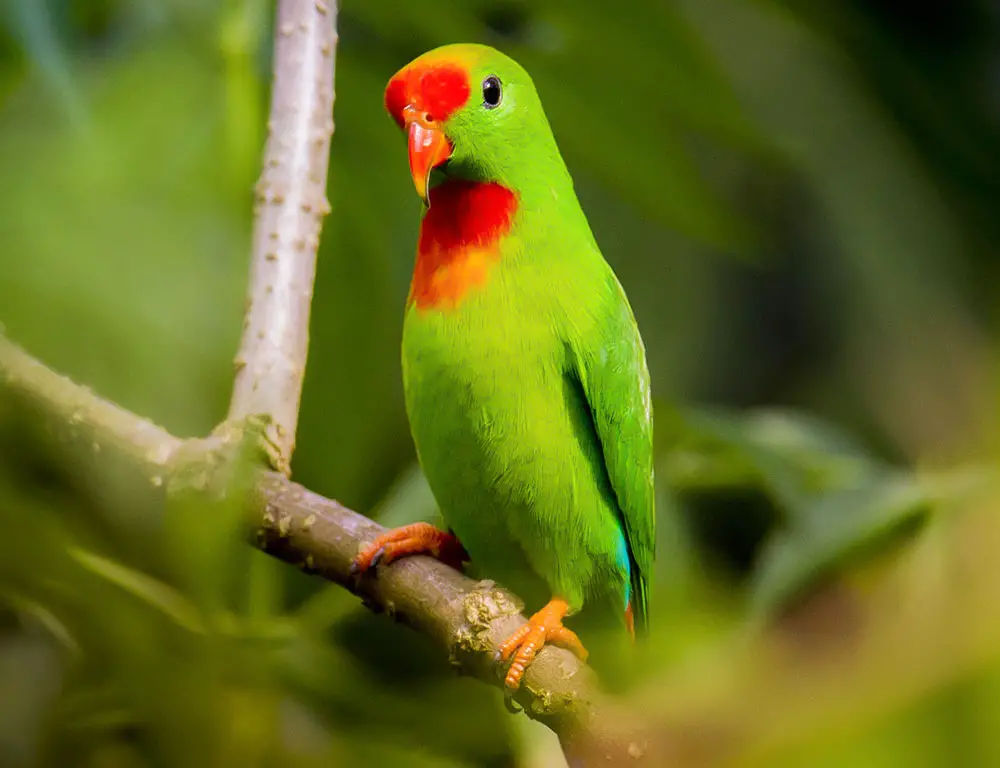Enthralled by the kaleidoscope of avian life, one species stands out amidst the canopy: the Philippine Hanging Parrot, also known as the Colasisi. Its petite frame adorned in vibrant green plumage, accented by a fiery red throat patch, beckons attention.
Originating from the lush landscapes of the Philippines, this diminutive parrot enchants not only with its visual splendor but also with its peculiar behaviors. Did you know they slumber suspended upside down, akin to bats?
It’s a whimsical trait that defies convention and adds to their allure. With each unique characteristic, the Philippine Hanging Parrot serves as a testament to the ingenuity of nature, captivating enthusiasts and scholars alike, perpetually beckoning exploration into its enigmatic world.

Physical Characteristics of Philippine Hanging Parrot
The Philippine Hanging Parrot (Loriculus philippensis), also known as Colasisi, is a small and colorful bird native to the Philippines.
Here are the physical characteristics of this fascinating species:
Size
Philippine Hanging Parrots are relatively small birds, measuring around 13 to 15 centimeters (5 to 6 inches) in length from beak to tail.
Plumage
These parrots are predominantly green, with shades varying from bright emerald to olive green. Their green plumage helps them blend into the lush foliage of their forest habitats, providing camouflage from predators.
Red Rump
One of the most distinctive features of the Philippine Hanging Parrot is its bright red rump, which contrasts vividly with its green body. This splash of color is particularly noticeable when the bird is in flight or perched in the canopy.
Blue Head and Throat
Some subspecies of the Philippine Hanging Parrot exhibit patches of blue on their heads and throats. This blue coloration adds to the bird’s visual appeal and complements its overall color scheme.
Beak
These parrots have small, curved beaks that are orange-yellow. The shape of their beaks is adapted for feeding on fruits, seeds, and nectar, which are primary components of their diet.
Eyes
The eyes of the Philippine Hanging Parrot are typically dark brown or black, framed by a narrow white eye-ring. This eye-ring adds a subtle highlight to their facial features.
Tail
Their tails are relatively short compared to their body size and are often hidden by the dense foliage of their forest habitat. The underside of the tail may display some red or yellow coloration, depending on the subspecies.
Habitat and Distribution of Philippine Hanging Parrot

The Philippine Hanging Parrot, also known as Colasisi, is endemic to the Philippines and can be found across various archipelago islands.
Here’s a closer look at their habitat and distribution:
Habitat
- Forest Ecosystems: Philippine Hanging Parrots primarily inhabit tropical and subtropical forest ecosystems. They are often found in dense, humid forests with tall trees, where they can find suitable nesting sites and abundant food sources.
- Altitude Range: While primarily dwell in lowland forests, they have also been observed in montane forests at higher altitudes, up to around 1400 meters above sea level.
- Proximity to Water Bodies: These parrots stay near water bodies such as rivers, streams, or lakes. This proximity to water sources may be related to their diet, as it ensures a steady supply of fruits and seeds, their primary food sources.
- Adaptability: Despite their preference for forested areas, Philippine Hanging Parrots have shown adaptability to cultivated areas and plantations. However, their survival in such environments often depends on the availability of suitable food and nesting sites.
Distribution
- Endemic to the Philippines: The Philippine Hanging Parrot is native only to the Philippines and is not found naturally in any other part of the world.
- Island Distribution: They are distributed across various islands of the Philippines, each hosting its bird subspecies. Some islands where they can be found include Luzon, Mindanao, Leyte, Samar, Bohol, and Palawan.
- Subspecies: Each island may have its distinct subspecies of the Philippine Hanging Parrot, exhibiting slight variations in coloration and size. For example:
- Luzon: Colasisi luzoniensis
- Mindanao: Colasisi mindorensis
- Leyte: Colasisi leyteensis
- Samar: Colasisi samarensis
- Bohol: Colasisi boholensis
- Palawan: Colasisi palawanicus
Conservation Status of the Philippine Hanging Parrot

The conservation status of the Philippine Hanging Parrot, scientifically known as Loriculus philippensis, is a matter of concern due to the various threats it faces in its natural habitat.
Here’s an overview of its conservation status:
IUCN Red List Status
As of the most recent assessment, the Philippine Hanging Parrot is categorized as “Near Threatened” on the International Union for Conservation of Nature (IUCN) Red List.
This classification indicates that the species is at risk of becoming threatened with extinction shortly if conservation efforts are not implemented effectively.
Threats
- Habitat Loss: One of the primary threats to the Philippine Hanging Parrot is habitat loss due to deforestation and habitat degradation. The conversion of forests for agricultural purposes, logging, urbanization, and infrastructure development has led to the destruction and fragmentation of its natural habitat.
- Illegal Pet Trade: Another significant threat to the species is the illegal capture and trade of wild birds for the pet trade.
The attractive appearance and ability to mimic human speech make the Philippine Hanging Parrot highly sought after in local and international markets. Illegal trapping and trade deplete wild populations and disrupt natural breeding and population dynamics. - Climate Change: Climate change poses additional challenges to the survival of the Philippine Hanging Parrot and its habitat.
Changes in temperature and precipitation patterns can alter forest ecosystems, affecting food availability, nesting sites, and overall habitat suitability for the species.
Conservation Efforts
Several conservation initiatives and measures are being undertaken to protect the Philippine Hanging Parrot and mitigate the threats it faces:
- Habitat Protection: Conservation organizations and government agencies are working to establish and manage protected areas, wildlife reserves, and forest corridors to conserve the species’ habitat and ensure connectivity between fragmented populations.
- Law Enforcement: Efforts to enforce laws and regulations against illegal logging, hunting, and wildlife trade are crucial for combating the illegal capture and trade of Philippine Hanging Parrots.
- Community Engagement: Collaborative efforts involving local communities, indigenous peoples, and stakeholders are essential for raising awareness, promoting sustainable land use practices, and involving communities in conservation activities.
- Research and Monitoring: Research projects focused on the ecology, behavior, population dynamics, and threats facing the Philippine Hanging Parrot are essential for informing conservation strategies and monitoring the effectiveness of conservation efforts.
Conclusion
The Philippine Hanging Parrot, or Colasisi, stands as a testament to the rich biodiversity of the Philippines. Its vibrant green plumage, blue throat patch, and unique hanging behavior captivate admirers worldwide.
However, this iconic species faces threats from habitat loss and illegal pet trade, underscoring the urgent need for conservation efforts. Understanding and spreading awareness about these birds’ challenges are crucial for their preservation.
Each species, including the Philippine Hanging Parrot, is vital in maintaining ecological balance. As we marvel at their resilience, let’s commit to protecting their habitats and ensuring their survival for future generations.
By nurturing Mother Earth and respecting all living beings, we can ensure a world where every species thrives.